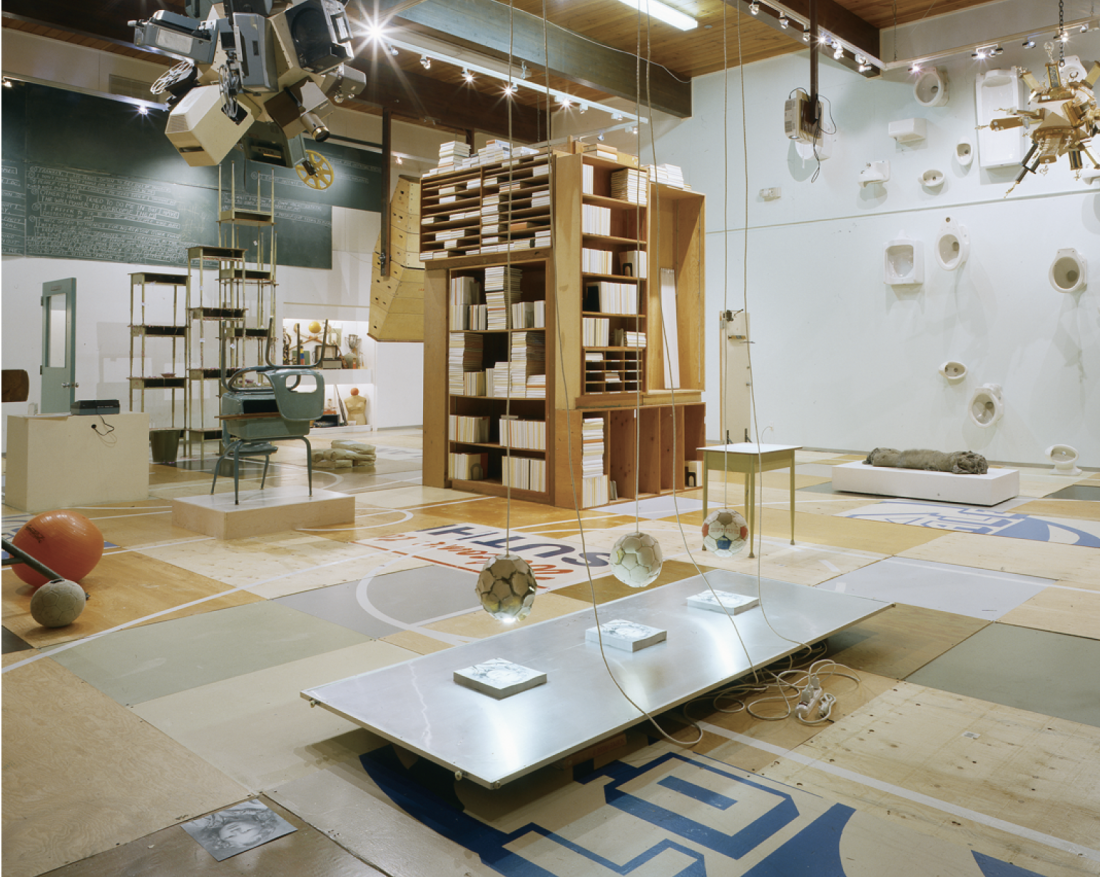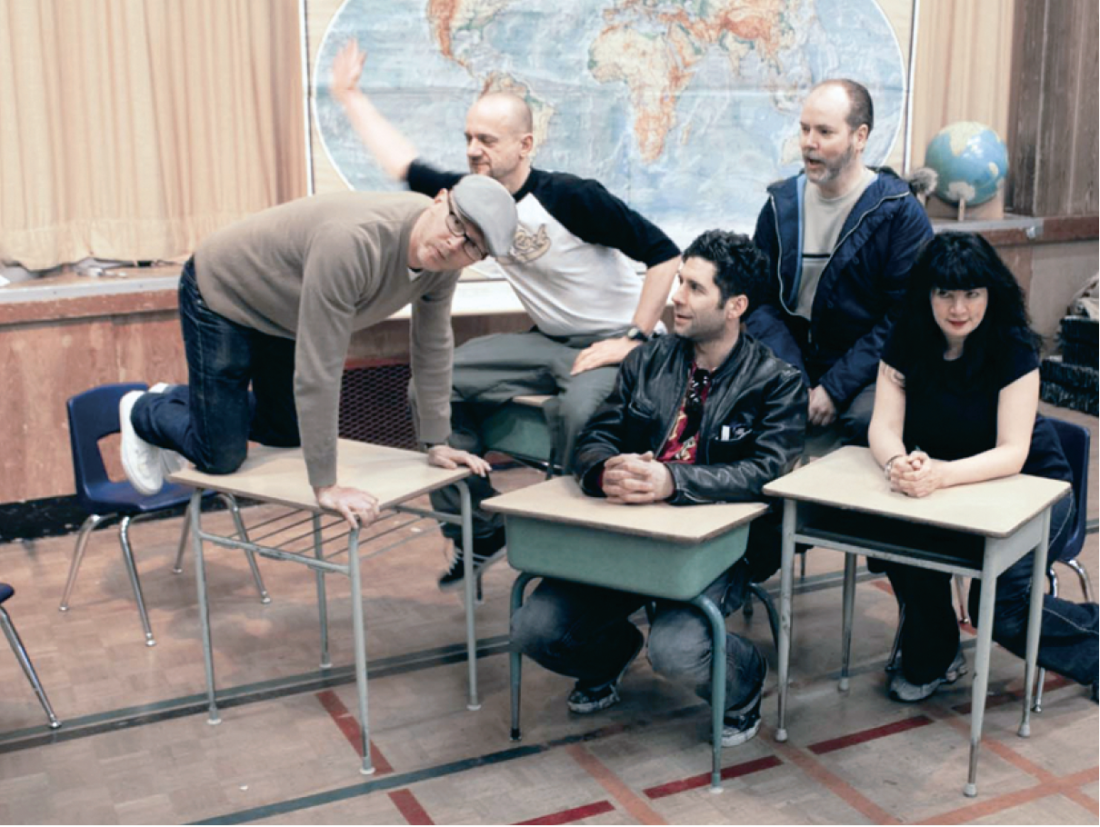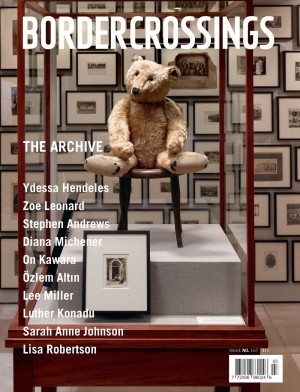“Vancouver School”
School reunions are emotionally charged occasions, times in which we wonder whether the friendships and camaraderie of our teen years will have prevailed over the spites, rivalries and exclusions and whether we’ve achieved enough in our adult lives to make good our youthful promise, avenge our adolescent misery, or redress seeming ages of anxiety, frustration or boredom. Rarely do we think about the place that is school, nor what its drab, utilitarian architecture and sub-drab materials and furnishings might signify. But that’s exactly what the exhibition “Vancouver School” demanded: that we reconsider the nature of school through an encounter with its reassembled physical forms.
A collaborative installation by five acclaimed local artists, Douglas Coupland, Graham Gillmore, Angela Grossmann, Attila Richard Lukacs and Derek Root, “Vancouver School” took its cheeky title from the name bestowed by critics upon the city’s internationally renowned and institutionally dominant photo-based artists. Equally cheeky was the exhibition poster photo: Grossmann, Gillmore and Root sit at tiny, primary school desks, watching with amusement, apprehension or pseudo-innocence as Lukacs smacks Root on his upraised bum. Both title and poster were clues to the project’s underlying humour and political challenge.
Although they conspicuously are not members of the Vancouver School, this gang of five were students together. During the early 1980s, all attended what is now the Emily Carr Institute of Art, Design & Media in Vancouver. There, they became close friends and coconspirators, working together, exhibiting together, launching their careers together. With the exception of Coupland, who studied sculpture and has since become a highly successful writer, designer, cultural commentator and Gen- X Renaissance guy, all were then painting figurative works in a neo-Expressionist style. Although most of them have shifted to other approaches and subjects, they continue to be identified with the titles of shows in which they participated two decades ago: “Futura Bold” and, more widely and persistently, “Young Romantics.”

Installation, “Vancouver School,” 2006. Photographs: David James.
The Artists for Kids Gallery (AFK), in which “Vancouver School” was installed, was formerly a school gymnasium. (AFK is an educational trust that funds expanded art programs for K to 12 students in the North Vancouver school district. Its gallery, the site of an active program of exhibitions, school tours, lectures and workshops, is open to a broad spectrum of visitors.) Invited to create a collaborative work in the space, the artists chose to reconvert it into a gym of sorts, then fill it with radically altered, displaced and realigned school fixtures, forms, furniture, equipment and accoutrements. These included everything from washroom partitions to chalkboards, bookshelves, fluorescent lighting, student desks, a public address system, the cut-down furnishings of a principal’s office and the entire façade (with curtain) of an assembly-room stage.
Almost all these forms, objects and materials were salvaged by the artists from a decommissioned high school, to which they were given complete access a few months prior to the opening of their show. Grossmann commented that the group appropriated everything that wasn’t nailed down—and a lot that was. Coupland added that the freedom to take a crowbar to virtually everything in that old, shutdown school gave him the further freedom to dismantle—at least in his mind—every public building in which he has since found himself. Physical demolition functioned for this group as both a literal and metaphoric form of deconstruction.
The exhibition successfully linked the idea of school with its built aspects. In other words, it functioned as an institutional critique, asking adult and student viewers to examine ideas of authority embedded within the architecture and furnishings of learning. It also raised questions about successful design. For instance—if something is built purely for functionality and indestructibility, not for pleasure, not to gratify any aesthetic impulse, what happens when it is rendered non-functional? When it is taken apart or hung upside-down on a wall or ceiling? How do such strategies change the object’s or structure’s meaning? For those who long ago left school, the show also served as a register of body memory, triggering a myriad of emotional associations and responses. In modernist design, form may follow function, but in this postmodern installation, feeling followed form.
“Vancouver School” settled itself somewhere between an interactive diorama, an entertainment centre and an adventure playground. Old educational films, apparently shot in the 1970s, were spliced together to create a tongue-in-cheek cautionary tale about teen alienation and drug use. This component was screened in a storage closet outfitted with two swings. A new video work, shown in a yellow school bus sitting in the courtyard adjacent to the gallery, depicted a near-naked Gillmore climbing toward the top of a tree and donning clothing as he ascended through its branches, suggesting an ongoing process of maturity, respectability and social accommodation.

The artists of the “Vancouver School.”
Two big “death stars,” one spiked with old sports trophies and the other with obsolete audio-visual equipment, hung from the ceiling on heavy chains. Urinals, drinking fountains and toilets were bolted to one wall at varying, unusable heights and angles. Another wall was oddly contiguous with a curving wooden floor, whose found plywood panels were painted with white lines connoting various indoor sports. Both the lines and the curving floor drew the eye upward to a series of green chalkboards mounted high above. Some boards bore found text, the chalky ghosts of science classes past (“What do you like best about electricity?”), but most bore convoluted, ass-backwards questions from a psychological test (“I feel very guilty because I am not able to do things right anymore”). The questions, from an anonymous source, composed a kind of flypaper for trapping moments of unguarded incomprehension and confused self-worth.
Altered gym equipment ranged from revenge-of-the-nerd works (a parallel bar carved to look like a giant pencil) to terrifying amplifications of feelings of impossibility (two saddle vaults bolted together end-to-end, hanging from the ceiling and rotating every so often, perilously close to the viewer). A thick, grotty layer of compressed, lint-like dust, found behind a wall, was rolled up to create a freaky, faceless biomorph that heaved, breathed and farted from unseen mechanisms within. Stacked-up student desks, covered with blobs of chewing gum (to which visitors were encouraged to contribute), rose in towers towards the ceiling. Bookshelves and mail slots composed a central architectural structure that both offered and refused communication.
A condition the five artists set themselves at the outset of their project was that they would, indeed, work collaboratively and leave their individual and characteristic styles at the door. On the whole, they succeeded in erasing their distinctive identities, although Lukacs managed to smoke a realistic drawing of an attractive young man onto a washroom partition that stood outside the gallery’s front entrance. (On re-examination, it seems he did leave his personal style at the door….) The group’s major accomplishment, however, was not self-erasure, but the creation of a scene of real-surreal disruption and disjunction within which we were able to reformulate understanding and reinterpret experience. Within which, too, we encountered some essence of what school meant and means. ■
“Vancouver School” was exhibited at the Artists for Kids Gallery in North Vancouver from April 18 to May 13, 2006.
Robin Laurence is a writer, curator and a Contributing Editor to Border Crossings from Vancouver.

